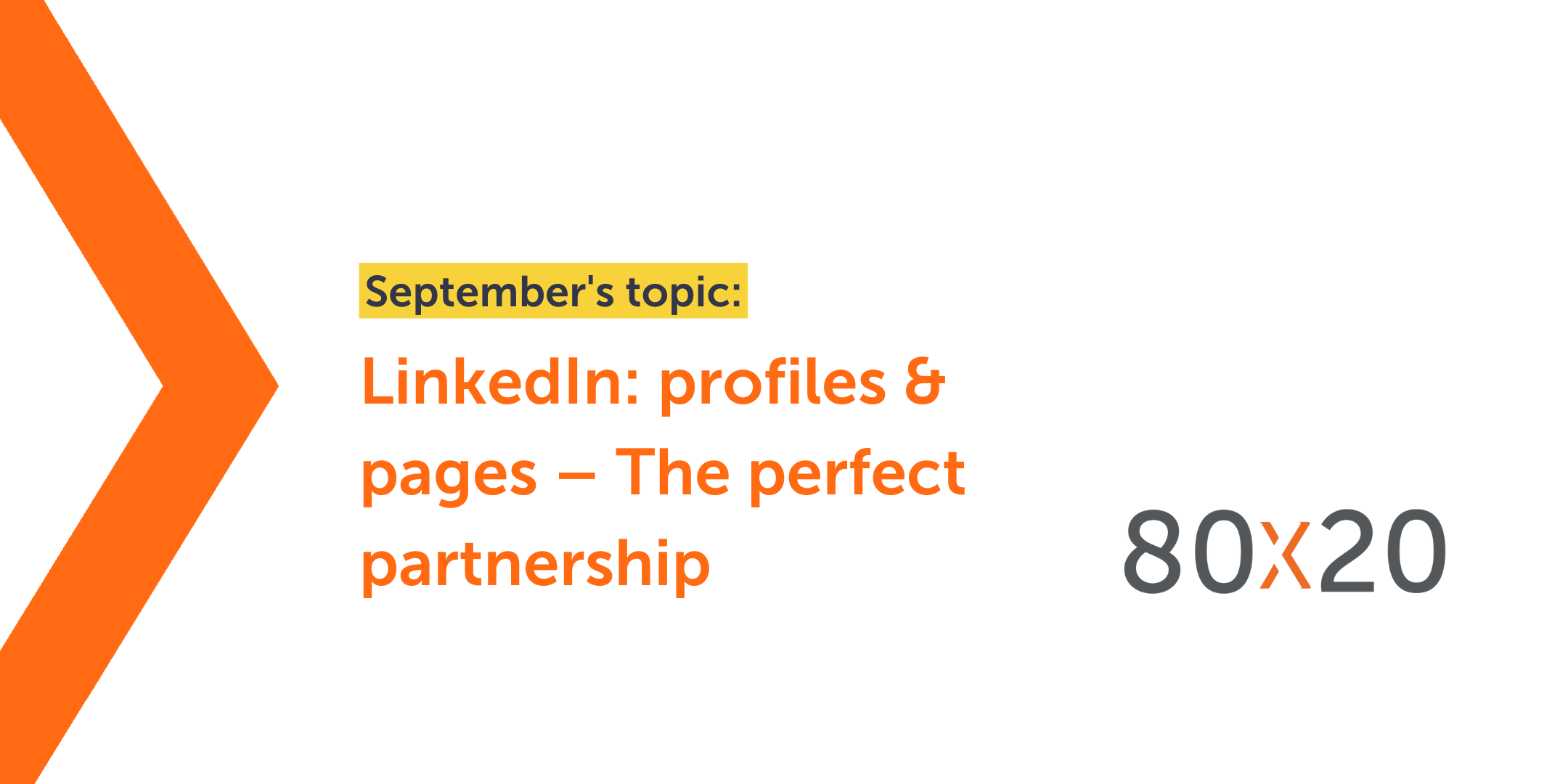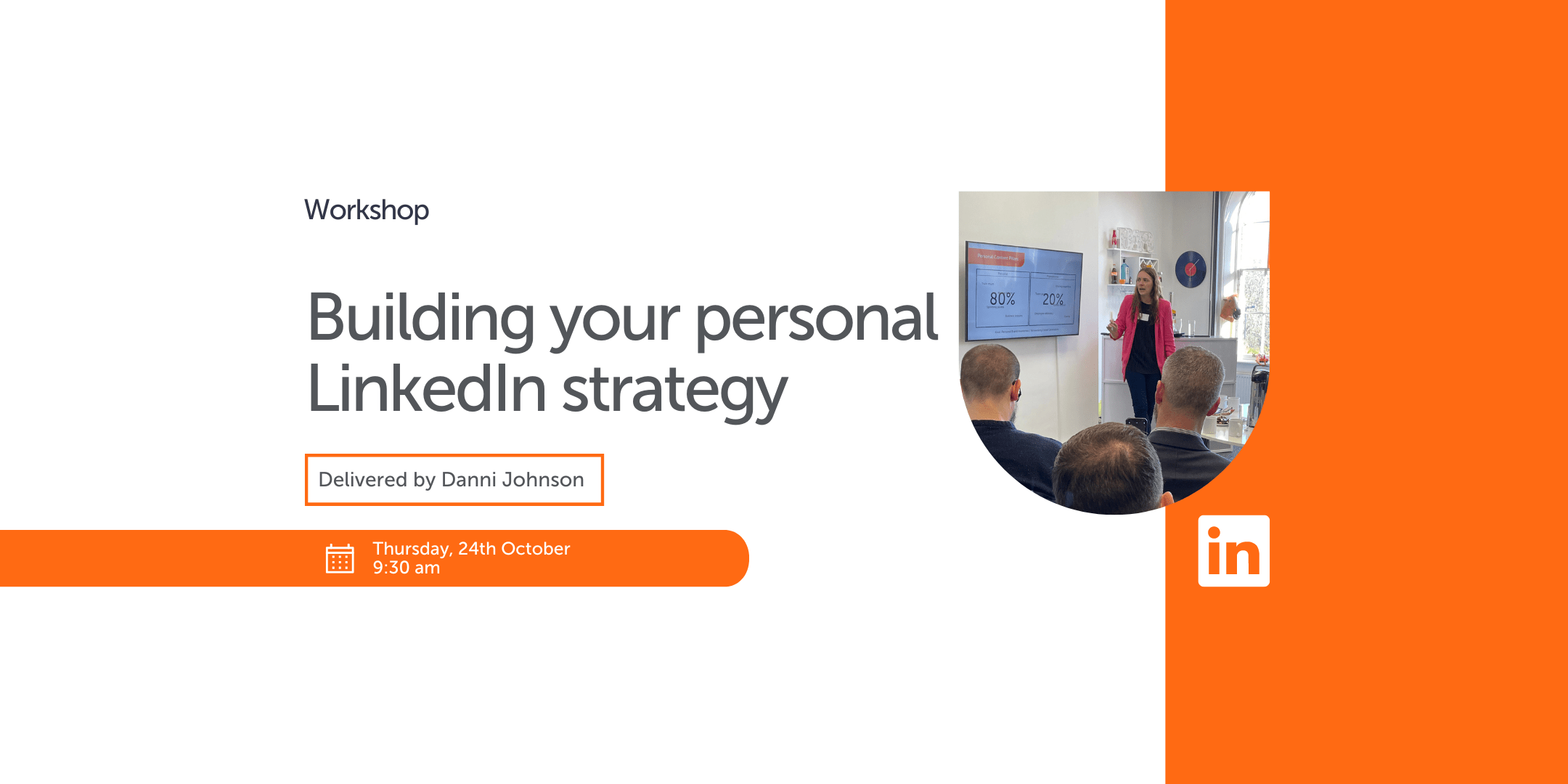On Thursday the 26th of January 2023, we held our first 80×20 networking event of the year and it was one of our best attended to date! You can find a recap of what we covered, below.
Why 80×20?
80×20 is a series of events created by Xpand that allow you to learn about the latest in the digital marketing world, while getting the chance to network with other business owners and marketing professionals.
In January we covered…
In January’s ‘20 minute mastery’ the subject was – How to establish LinkedIn as a sales generation tool.
LinkedIn is more than just a networking tool. When it’s used in the right way, it can become an extremely powerful sales tool.
Danni, our LinkedIn specialist shared key insights for business owners, who want to take their LinkedIn strategies to the next level.
Attendees learned:
- The importance of building a strong personal brand and how to do it on LinkedIn
- How to use LinkedIn’s advanced search features to identify and connect with potential clients and build your network
- How to understand if what you’re doing is working
- Introducing the SSI (social selling index) score
- Your dashboard analytics
- Case studies and success stories of businesses we’ve worked with that have successfully used LinkedIn to generate sales, and much more!
Video
Slides
Did you know…
Men use LinkedIn as a substitute for Tinder 17 times more than women (yikes!).
89% of all members value LinkedIn as a trustworthy source of information, compared to 64% on Twitter and 37% on Facebook.
80% of B2B leads come from LinkedIn.
Why is building your personal brand important?
When we talk about personal branding, we’re going beyond the business brand. Personal brand is about you as an individual as opposed to your business brand.
Business leaders heavily focus on whether they are B2B (business to business) or B2C (business to consumer), but what most don’t realise is that they’re always going to be H2H (human to human).
People buy from people no matter what business arena you’re in, or what industry. At the end of it all, you’re dealing with a human. Whether that’s a client, a supplier, a partner, or a customer.
Why is building your personal brand on LinkedIn important?
As a business leader, why would you want to build your personal brand on LinkedIn, and why is it important?
Well, there are 875 million people on LinkedIn, and 89% of those members value the platform as a trustworthy source of information.
So there’s a huge opportunity to reach people who you wouldn’t reach in your day-to-day interactions. The pool is much bigger than you’d have access to in your local area.
You now understand the importance of building a personal brand on LinkedIn as a business leader, but how do you go about executing it?
Personal branding strategy
Like everything in marketing, it’s important to start with a strategy. As they say, failing to plan is planning to fail.
Generally, when we talk to prospects, they tell us that they’re on LinkedIn but not really contributing, all they have is a presence. They might contribute now and again, share a post here and there, or comment once in a while, but generally they don’t really have any strategy behind their actions.
This’ll get you minimal results, if you’re looking to build a solid personal brand on LinkedIn. Just as you wouldn’t run a marathon without the proper training, why approach your marketing that way?
It’s important to look at what your objectives are with LinkedIn, is it sharing your expertise, is it to get more clients, or maybe you just want to grow a bigger network of connections?
Whatever the case, you need to add this to your daily business objectives so it becomes a non-negotiable task on your calendar.
If you struggle to know what to do, get some training or find a specialist that can show you the ropes. And then execute, consistently.
Things to think about when planning your personal branding strategy
Here are a few things that you can think about when it comes to building your personal brand on LinkedIn:
Treat your profile as a landing page
Your LinkedIn profile is like a landing page for new connections. Throughout the profile you are building credibility and telling them why they should connect with you.
The difference between all your other social media profiles and your LinkedIn profile is that LinkedIn is a networking tool. It acts almost like your company website, except you have access to thousands of people who have the potential to become your connections and prospects.
For this reason your profile should follow the same principles as a website landing page, to do this you need to treat it like a sales funnel.
Once you’ve managed to get someone to your profile, is it successfully working them down the sales funnel? Does it capture their interest, does it show them the benefits of connecting with you, does it build credibility?
You need to think – is it giving them the information that will help them move through each stage to click the connect button?
Take full advantage of LinkedIn profile tools
LinkedIn is great because it tells you what you need to do to improve your profile score. You can work through the ‘add to profile’ section and optimise your profile according to the suggestions made. The more you complete this section, the better your profile will do in the search results.
There’s also a new section called ‘services’ that allows you to list your services and products. The benefit of this is if someone goes on to the search bar and searches for a service you’ve listed, LinkedIn notifies you about that search.
You can then reach out to that person and make a connection and tell them about what you offer.
Targeting the right people
Remember with LinkedIn it’s not about quantity, it’s about quality. It’s better to have less connections that you’ve built solid relationships with than to have hundreds who you’ve never reached out to, or interacted with.
But this also doesn’t mean you shouldn’t make any new connections. Just make sure you’re active about it and once you’ve made the connections you’re keeping in touch or following up to deepen those relationships.
How can you find relevant people to connect to? Use the LinkedIn search bar, it’s a valuable tool if you know what to search for. By now you probably already know your target audience, so start typing some key words related to them into the search bar, and start making those connections.
Engage, nurture and grow
The worst thing you can do on LinkedIn is to post and then leave the platform. Don’t do this. Make sure you’re engaging, commenting and liking other posts after you’ve posted your own content. You need to be spending time on the platform.
Make sure, before you post something, that you’re engaging on the platform and with other users. This can be through interacting with other people’s content such as commenting, liking or sharing posts. Then post your content. And then make sure you’re sticking around after posting too.
Creating an audience focussed content plan
This is such a simple step but often missed, so many people just post random stuff on their profile. Think about your audience, what information are they looking for?
You can create a plan by outlining the ‘content pillars’ your content will fall into. For example Danni has a personal content pillar and a promotional content pillar. Within these pillars are the different topics she will talk about.
It can look something like this:
You can create something similar as a guide so you always know what topics to cover in your content.
Once you have your content pillars, make sure you’re not always posting promotional content. There should roughly be an 80-20% split, so 80% personal posts and 20% promotional things about your team, business etc.
Testing and analysing, then testing again
With social platforms forever changing, it’s important to keep testing what’s working and what isn’t. You can sometimes put the same post out twice and it can perform completely differently to each other.
This is why you should constantly test the timings, the lengths of your posts and other factors so you can understand what works for you and your audience.
The SSI score
Those with an SSI score of 70 or more have an average increase in reach of 25% – Algorithm research edition 2022 – Just Connecting
SSI stands for Social Selling Score, and if you’re on LinkedIn, you have one. You can find what yours is by searching for SSI score on Google.
Make sure you’re looking at it regularly as your SSI is LinkedIn’s measure of the strength of your profile and presence. It’s scored from 0 to 100, in 4 categories, each worth 25 points and is updated every 3 days.
The dashboard looks like the one below:
The LinkedIn dashboard
This is the analytics dashboard for LinkedIn, it’s private to you so no one else can see this. It’s full of valuable data that you can use to improve your LinkedIn efforts.
Here you can see:
- How many people are viewing your profile
- The stats behind your activity
- How often you’re appearing in searches, and much more
This is all useful information but what does it mean, and which metrics are important?
The most useful metric you can look at are post impressions. Post impressions give you an indication of the performance of your content.
It gives you an indication of how well your content is performing, it can show you any trends, and you can see which posts resonated with your audience, by looking at the engagements on the posts.
All this data can help you double down on content that resonates well with your audience and create more of it.
Example 1 – Danni’s personal post
Danni posted about the snug we have here at Xpand, as you can see it’s nothing to do with promoting Xpand’s services. It’s a personal post where Danni is simply appreciating the new lounge area that has recently been added.
But as you can see, the post got great impressions and even better engagement. The target demographic is also relevant people that Danni is looking to connect with.
Example 2 – Chris Makin
Chris Makin is one of our clients who we’ve been working with for a long time. He’s a highly experienced chartered forensic accountant. We’ve been working on his LinkedIn strategy and here’s what he had to say:
“With your new posting this week some good reactions from familiar contacts, and invites to quote for three new jobs last week. And when a ‘job’ for me is typically £5-10,000, that’s very worthwhile. In fact, I’m just about fully committed now until Christmas”
Example 3 – Tracy Barnes
Tracy is a commercial finance specialist that we’ve worked with to improve her LinkedIn personal brand. Tracey followed our commenting strategy and gained new business from a connection request that she would’ve never seen, if she hadn’t commented.
Here’s what she had to say:
“The next day I got a connection request and a private message from an ex-pat living in Switzerland wanting to purchase up to 50 BTL properties over the next 5 years, before returning to the UK to retire. I currently have three deals on the go for him which will be worth about £6000 in commission to CEx, with many more to come. Commenting on others’ posts definitely works.”
Hopefully, you can now see from the examples that if you put in the time and use the strategies we’ve shared, you can get some great results with your LinkedIn efforts.
Want to start using LinkedIn to generate more leads and sales? Why not see how we can help, get in touch with our team.


